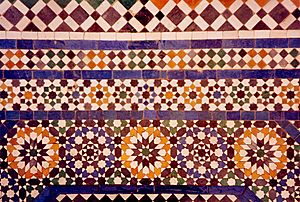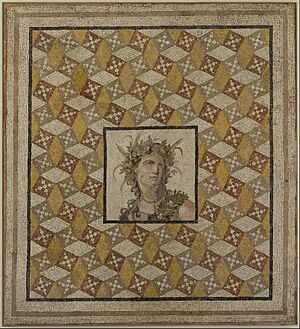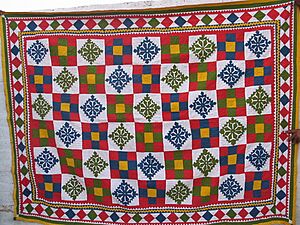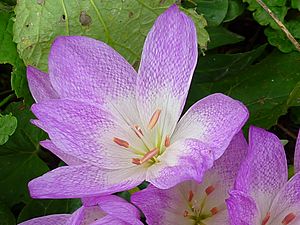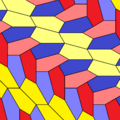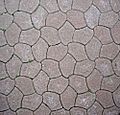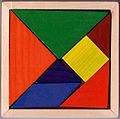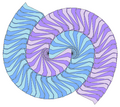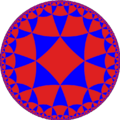Tessellation facts for kids
Tessellation is when you cover a flat surface with shapes that fit together perfectly. There are no gaps between the shapes, and they don't overlap. These shapes are often called tiles. You can see tessellations everywhere, from ancient buildings to modern art.
The word "tessellation" comes from the Latin word tessella. This means a small square piece of clay, stone, or glass. These pieces were used to make mosaics. The everyday word tiling is another way to talk about tessellations.
You can find tessellations in many places. Think about the patterns in a honeycomb or the tiles on a floor.
Contents
History of Tessellations
People have studied tessellations for a long time. In 1619, a scientist named Johannes Kepler wrote about them. He looked at how regular shapes, like squares or triangles, could cover a flat surface.
Later, in 1891, a Russian scientist named Yevgraf Fyodorov made a big discovery. He showed that there are only 17 different ways to repeat a pattern on a flat surface. This was a key moment in the mathematical study of tessellations. Many other smart people have also added to our understanding of these patterns.
What is Planar Tiling?
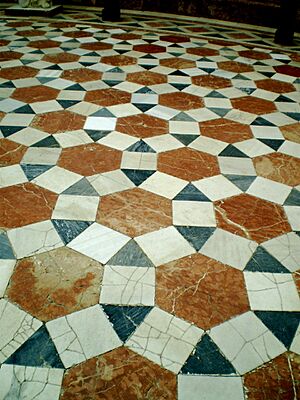
When we talk about tessellations on a flat surface, it's also called planar tiling. This part of geometry looks at how shapes, or tiles, can fill a flat area. The main rules are simple: the tiles must not have any gaps between them, and they must not overlap. Also, a corner of one tile should not lie along the edge of another tile.
Tessellations in Art and Design
Tessellations have been used in art for thousands of years. Ancient civilizations used them to make beautiful patterns in mosaics. Later, artists used larger tiles, sometimes plain and sometimes decorated.
The Moorish artists in Islamic architecture created amazing wall tiles. They used special Girih and Zellige tiles. You can see these stunning patterns in buildings like the Alhambra and the La Mezquita in Spain.
The artist M. C. Escher is famous for his tessellation art. He created many drawings where animals or other figures fit together perfectly.
You can also find tessellated designs on textiles. These patterns appear on woven fabrics, stitched designs, or printed clothes. Many quilts use tessellation patterns to connect different fabric shapes.
Even in origami (paper folding), tessellations are important. People use special folds to connect repeating shapes together.
Tessellations in Manufacturing
Tessellation is very useful in factories. It helps reduce waste when cutting materials like sheet metal. For example, when making car doors or drinks cans, companies use tessellation. This way, they can cut out as many shapes as possible from a single sheet. This saves a lot of material and money.
Tessellation patterns can also be seen in how thin films crack. This happens with very small materials, like those used in micro and nanotechnology.
Tessellations in Nature
Nature is full of tessellations!
- Basalt Columns: When lava cools, it often cracks into amazing columns. These cracks form a network that creates hexagonal lava columns. A famous example is the Giant's Causeway in Northern Ireland.
- Tessellated Pavement: This is a rare rock formation where the rock breaks into rectangular blocks. You can see a great example at Eaglehawk Neck on the Tasman Peninsula in Tasmania.
- Plants: In botany, "tessellate" describes a checkered pattern. You might see this pattern on a flower petal, tree bark, or even on some fruits.
- Honeycombs: Bees build their honeycombs using hexagonal cells. These cells fit together perfectly, forming a natural tessellation.
Images for kids
-
A temple mosaic from the ancient Sumerian city of Uruk IV (3400–3100 BC), showing a tessellation pattern in colored tiles.
-
The colorful zellige tessellations of glazed tiles at the Alhambra in Spain. These patterns inspired M. C. Escher.
-
The 15th convex monohedral pentagonal tiling, found in 2015.
-
Tessellating three-dimensional space: the rhombic dodecahedron is one of the shapes that can fill space exactly.
-
A honeycomb is a natural tessellated structure.
-
A traditional tangram dissection puzzle.
-
The Voderberg tiling, a spiral, monohedral tiling made of enneagons.
-
Alternated octagonal or tritetragonal tiling is a uniform tiling of the hyperbolic plane.
See also
 In Spanish: Teselado para niños
In Spanish: Teselado para niños


